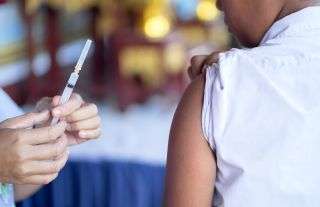
Could the flu vaccine combat the coronavirus? That’s the question President Donald Trump asked during a White house roundtable discussion between his coronavirus task force and pharmaceutical company executives on Monday (March 2).
His question was answered with a direct “no” from an executive. The flu vaccine is designed to prevent infections with influenza viruses, which are very different than coronaviruses. But the answer is slightly more complicated than that: The flu vaccine won’t prevent you from getting a coronavirus, but it can help officials better respond to the outbreak of COVID-19, the disease caused by the new virus.
“I do think immunizing people against influenza has a very important indirect effect,” said Dr. Albert Ko, a professor and department chair at the Yale School of Public Health.
Latest Coronavirus News
—Live updates on the coronavirus
—What are the symptoms?
—How deadly is the new coronavirus?
—How does it compare with seasonal flu?
—How does the coronavirus spread?
—Can people spread the coronavirus after they recover?
First, health care workers are already burdened by flu cases so getting a flu shot, reduces the number of flu patients, thereby helping to “relieve pressures” in hospitals also treating patients with COVID-19, he said.
But there’s another reason a flu shot could improve the country’s response to the new outbreak: the U.S. is lagging behind other countries in testing for COVID-19. And that’s unlikely to improve in the near term. On Thursday (March 5), Vice President Mike Pence, who is leading the administration’s response to the coronavirus, announced that the U.S. does not have enough test kits to meet demand.
How does that relate to the flu? If people get their flu shots, fewer people come down with the flu and come into clinics with nonspecific symptoms such as fever and cough, which overlap with symptoms of COVID-19.
Having fewer flu patients will make it easier to find the patients with COVID-19, he said.
Higher vaccination rates would “make us much more efficient in detecting coronavirus,” cases, Ko told Live Science. Finding COVID-19 cases is still akin to picking a “needle out of a haystack,” but reducing flu cases can “decrease the haystack,” he added.
As SARS-CoV-2 is spreading in communities on both coasts of the U.S., distinguishing between flu and COVID-19 will become more difficult.
On the bright side, it is “incredibly rare,” to catch both the flu and COVID-19 at once, said Dr. Eric Cioe Peña, director of Global Health, Northwell Health in New York and an emergency room physician. “Usually if they have one, they don’t have the other.”
Flu season is naturally dying down as spring approaches, but for those who haven’t yet done so, “we still recommend getting a flu shot,” he added.
People with the flu are still coming into the hospital and there’s always a chance there could be a second spike of the flu, Peña told Live Science.
That being said, flu cases in New York City have been down 25% each week for the past two weeks, he said. It’s a positive step “that we aren’t seeing as many flu patients in the ER, so we have more room for severe coronavirus patients,” Peña said.
At Northwell Health, patients aren’t being tested for COVID-19 unless they meet criteria for admission to the hospital. “That’s the only time that we’re really testing because of the limited supply of tests,” he added.
Sourse: www.livescience.com





